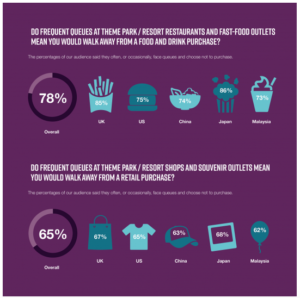This article is published in the White Paper category.
Theme parks’ original goal is to offer unique entertainment experiences to visitors. But victim of their own success, parks attract thousands of persons each day, implying extremely complex crowd management decisions to guarantee safety and smooth customer experience.
With a global market forecast expected to reach US$44.3 billion by 2020, theme parks and amusement parks’ operators see bright days ahead provided the customer experience remains central.
Since the first amusement parks opened in the eighteenth century, visitors’ habits have changed, so has technology. In fact, in 2018 a third of Asian theme park visitors (32%) would double their spending if they could use more innovative technologies, and, in 2017, 40% of amusement park visitors in the Netherlands said they would expect voice-controlled apps to be part of future technologies present in parks by 2020.
On the management side, Crowd Analytics technologies also offer seemingly endless business intelligence insights to improve marketing and advertisement strategies, as long as privacy laws are respected. But not only. Internet of Things and Big Data promise to revolutionise theme parks’ reality, starting from what might be the worst customer experience: never-ending queues.
/

Other Theme Parks such as Walibi Holland, offer visitors to pay for fast lane services via a mobile app to be installed on guests’ phones, like QSmart, allowing the system to wait in line instead of the customer.
According to a customer review concerning Disney’s FastPass+, in 2015, even with the FastPass+ technology enabled, popular attractions remained the ones with the greatest queues while others were empty, and remained unpopular. /
But as customers seem to remain reluctant to install mobile apps, a few theme parks have adopted digital wristbands, such as Disney’s Magic band or Universal Studio’s Tapu Tapu wristband. Indeed, if customers are no longer losing time queuing, they should have more time to spend their money. Thanks to RFID technology, these IoT wearables offer personalised experiences by triggering fast lane services, key-room-like access to the hotel, cashless payment and even to save pictures to the customer’s account.
Data privacy experts have nevertheless raised concerns regarding the amusement parks capacity to track children. In Disney‘s FAQ and privacy page, it is stated that customers are free to refuse to use the IoT wristband, although this implies enjoying less the park’s experience.
/
As theme parks are considered to spend the biggest share of their operations costs on employing staff, some park owners are choosing Big data, IoT and Crowd Analytics to manage productivity.
Planning to replace one-third of their employees with robots by 2021, H.I.S, the Japanese owner of the Huis Ten Bosch amusement park, will tackle the productivity cost this way. Disney, as part of their MyMagic+ digital innovation plan, is also working on productivity through prediction analytics. Staff’s location and number, as well as garment inventorying and cleaning, are done based on forecasting models built to save costs.
Belgian theme park Bobbejaanland has deployed free WiFi hotspots to cover the entire park. By detecting visitors’ phones connected to the WiFi and their access points, park managers have gathered useful information about the distribution of the crowd in the park allowing to adapt their service offer to the crowd’s density.
Thanks to its LBASense sensors, able to detect mobile phones that are using Wi-Fi protocol for data communication as well as mobile devices using access point information to improve their positioning, DFRC also provides unique Crowd Analytics for theme parks and amusement parks.

In addition to being able to measure mobility patterns, queues, compare several attractions’ real-time footfall, offer integration with CRM and marketing tools (including the park mobile app), and measure conversion rates inside and outside restaurants and shops, DFRC’s technology allows monitoring theme parks productivity.
In fact, by simply registering once the staff’s phone to the LBASense system (no mobile app is needed), human resource managers are able to locate in real-time their employees. For example, applied to maintenance staff in a huge site, it comes in handy to visualise the presence and contact number, on the web Dashboard’s screen, of the closest available repairman in order to send him quickly to fix a machine.
As staff can be tracked individually and per category, this solution is also suitable for cleaning persons to be sent à la carte anywhere when needed, or costumed actors to visit in real-time the most crowded areas of the park.
Contact us for a tailored scenario.

Data team
Copyright © 2022 DFRC
43 Science Park Road #01-11 Rm 8, Singapore 117408